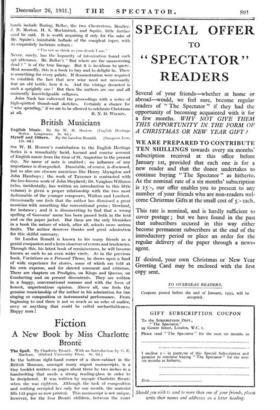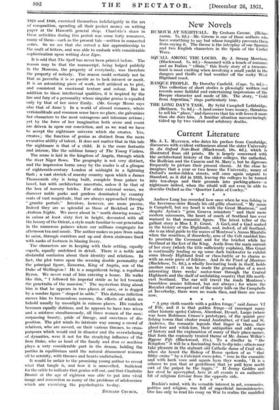Fiction
A New Book by Miss Charlotte Brontë
IN the bottom right-hand corner of a show-cabinet in the British Museum, amongst many august manuscripts, is a tiny booklet written on pages about three by two inches in a
handwriting that needs a strong reading-glass in order to be deciphered. It was written by myopic Charlotte Brontii when she was eighteen. Although the task of composition and scribing occupied her only for one month, the material fills 145 pages as now printed. This manuscript is not unique, however, for the four Bronte . children, between the years 1824 and 1840, exercised themselves indefatigably in the art of composition, spending all their pocket money on writing paper at the Haworth general shop. Charlotte's share in these activities during this period was some forty romances, many of them—such as the present tale—written in connected series. So we see that she served a fair apprenticeship to the craft of letters, and was able to embark with considerable sophistication upon writing Jane Eyre.
It is odd that The Spell has never been printed before. The reason may be that the manuscript, being lodged publicly in the Museum, the property of everybody, was therefore the property of nobody. The reason could certainly not be that as juvenilia it is so puerile as to lack interest or merit. It is an astonishing piece of work, well artificed as to plot, and consistent in emotional texture and colour. But in addition to these intellectual qualities, it is inspired by the tire and fury of a personality whose singular genius is equalled only by that of her sister Emily. (Mr. George Moore says also that of Anne !) In a world of absurd romance, where verisimilitude and common sense have no place, she galvanizes her characters to the most outrageous and inhuman actions ; yet by the force of her imagination both scene and event are driven in upon our conviction, and as we read we have to accept the nightmare universe which she creates. Yes, creates ; the function of genius as distinct from the mere evocative ability of talent. It does not matter that in this tale the nightmare is that of a child. It is the more fantastic and intense, like the sublime lunacy of The Young Visiters.
The scene is laid in the kingdom of Angria, through which the river Niger flows. The geography is not very distinct, and the impression borne away by the reader is of a glimpse of eighteenth-century London at midnight in a lightning flash ; a vast stretch of marshy country upon which a James Thomsonish city is being built, complete from palace to hovel, but with architecture uncertain, unless it be that of the box of nursery bricks. For other external scenes, we discover noble parks and gardens dominated by country seats of vast magnitude, that are always approached through " granite portals." Interiors, however, are more precise. Indeed they are as splendid as those of Beckford or The Arabian Nights. We move about in " north drawing rooms," in salons at least sixty feet in height, decorated with all the luxury of the Orient, a style made familiar to our generation in the numerous palaces where our millions congregate for afternoon tea and music. The author makes us pass from salon to salon, through corridors and up and down staircases lined with ranks of footmen in blazing livery.
The characters are in keeping with their setting, equally superb, equally undefined in detail. There is a noble and disdainful confusion about their identity and relations. In fact, the plot turns upon the seeming double personality of the principal figure, Zamorna, King of Angria, son of the Duke of Wellington ! He is a magnificent being, a regalized Byron. We never read of him entering a house. He walks like this, " I followed his imperial stride as he led towards the penetralia of the mansion." The mysterious thing about him is that he appears in two places at once, or is dogged by a sombre figure draped in sable." This dubious infliction moves him to tremendous sorrows, the effects of which we behold usually by moonlight in ruinous places. His conduct becomes equally dubious, and he appears to have two wives and a mistress simultaneously, all three women of the mos:. surpassing beauty, pride of lineage, and sweetness of dis- position. The plot winds its intricate way among a crowd of relatives, who are moved, on their various thrones, to cross- purposes which would end in disaster and the overwhelming of dynasties, were it not for the steadying influence of the Iron Duke, who as head of the family and dens ex machina plays a very considerable part in the drama, holding the parties in equilibrium until the natural denouement restores all to serenity, with thrones and hearts undisturbed.
It would be unfair to the promising young author to reveal what that tangle is, and how it is unravelled, Sufficient for the critic to indicate that genius will out, and that Charlotte Bronte at the age of eighteen was able to put into vivid image and concretion so many of the problems of adolescence which are exercisng the psychologists to-day.
RICHARD CHURCH.

































 Previous page
Previous page